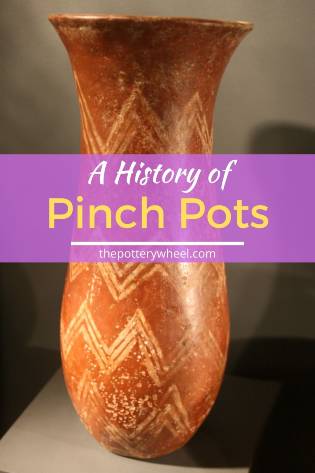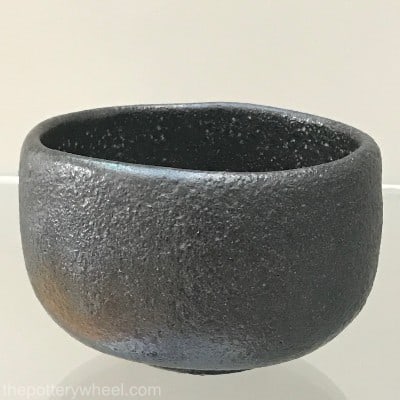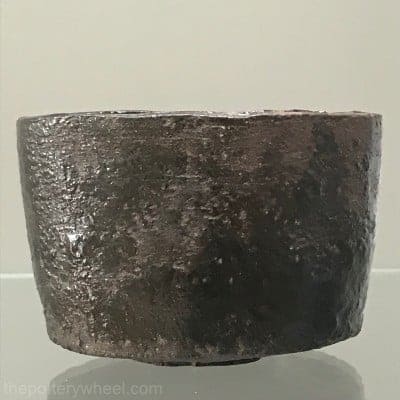Your cart is currently empty!
Pinch Pot History – A History of Pinch Pots Over the Years
Published:
Last Updated:

Affiliate Disclaimer
As an affiliate, we may earn a commission from qualifying purchases. We get commissions for purchases made through links on this website from Amazon and other third parties.
Pinch pots are one of the oldest ways of making pottery. There is evidence that pinch pot history starts many thousands of years ago. The simplicity of the technique has survived over the millennia. When I discovered that pinch pots were being made as far back as the Neolithic era, I was oddly reassured. It connects us to the past.
I like this feeling of connection to earlier eras when life was very different. So, I thought I would do some more research. And this is what I found out about the pinch pot history.

The Origins of Pottery
Evidence suggests that pottery first began around 20,000 years ago in China. There is a cave in eastern China called the Xianrendong Cave. Sherds of pottery dating back this long have been found in the cave. The cave was known to have been inhabited by people at that time.
There is also evidence of pottery dating back 10-16,000 years in Russia. This pottery was found on the Russian side of the Amur River, which is on the border of China and Russia. (source)
Pottery in the Western world was a bit slower to appear. Evidence of functional pottery in the West dates back to around 9000 years ago.
There is some disagreement among scholars about when and where the potter’s wheel was invented. Some suggest it was in Mesopotamia, now Iraq, around 3129 BC. Others argue that the wheel was first used in South Asia around 3500C.
Either way, functional pottery was being made long before the potter’s wheel was introduced. Prior to using the potter’s wheel, pottery was made using a variety of hand-building techniques. These techniques included the making of pinch pots.
A Pinch Pot History
The pinch pot technique involves shaping a piece of clay into a ball. Then press your thumb into the ball of clay and pinch the clay with your finger and thumb. This pinching action opens up the clay into a vessel shape.
Some ancient pots were made entirely using the pinching technique. Others were made using a combination of other hand building methods. The other hand building methods used were:
- Slab Building
- Molding
- Coiling
- Wheel Coiling
- Percussion (anvil and paddle)
A History of Small Pinch Pots
Small pots can easily be made using the pinching technique. A good example of this is the Japanese Tea Bowl, which has a long history stretching back to the 13th century.
The Japanese Tea Bowl can be made using a number of techniques. They are sometimes thrown on the wheel, giving them an even shape and design. Another technique is to carve them out of clay, scooping out the center of the clay bowl with a tool.
However, many ancient Japanese Tea Bowls were made using the pinching technique. Here is an example of two raku Tea Bowls dating back to the 17th Century.


Koetsu (1612-1637)
A History of Larger Pinch Pots
Larger pots can be made by joining two smaller pinch pots together. However, often larger pots were made using a combination of pinching and another technique.
There is a long tradition of combining pinching with coiling. And there is evidence of this technique all over the world, dating back many thousands of years.
It’s often assumed that ancient pottery was made exclusively using the coiling technique. And there is a lot to indicate that coiling was probably the dominant method.
However, archeologists have found evidence of pinching being combined with coiling as far back as the Bronze Age. For example, pinching and coiling were used in the Early Bronze age in Moravia Czechia. And a combination of slab, coiling, and pinching was used in Hungary in the Middle bronze age. (source)
Regional Differences
There are some similarities and differences between the way pinch pots are made in different regions. Here are a few comparisons…
British Pinch Pots
One example of the technique of combining pinching with coiling to make a larger vessel is Grooved Ware pottery. Grooved ware pottery was made in Neolithic Britain by flattening a ball of raw clay onto a mat.
The edges of the base were then pinched up to create the start of the vessel wall. Coils of clay were then added to the wall to build up height. The coils were compressed onto the vessel and then pinched upwards to extend the pot.
This pottery was called Grooved Ware because it was often scored with grooves as decoration.
Grooved Ware typically had a flat base and was straight-walled. However, the combination of pinching and coiling has been widely used around the world. And each region developed its own characteristic style and technique.
Japanese Pinch Pots
For example, Blandino, B (1984) describes what she called the extended pinch method. This was used in the Kyushu Province, Japan in the 16th and 17th centuries. A lump of clay was flattened between the palms of the hand. Then pressed against the lip of the vessel being built. The added lump of clay overlapped a bit onto the rim so that it would bond well. Then it was pinched upwards to add height.
Egyptian Pinch Pots
There is also evidence of pinch pottery being made as far back as 3000BC in Egypt. (Halls, S. 2014) The pots were often made out of clay from the Nile, or desert Marl Clay.
This ancient Egyptian pottery was made by scooping out the inside of a lump of clay. The clay was then pinched to thin the vessel walls. Some of these pinched pots from the Naqada period (4000-3000BC) were very thin-walled and refined in appearance.
Native American Pinch Pots
Many Native American tribes hand-built their pottery using a combination of coiling and pinching. Often the base of the vessel was made with a slab of clay. The walls of the base are then pinched upwards to form the shallow base of the pot. Additional coils are then added on and pinched into shape.
Final Thoughts
This article was a collection of information that I’ve discovered about pinch pots over the years. A complete pinch pot history would be a huge publication. There is evidence of pinch pots everywhere for thousands of years. I hope this article has given you some sense of the diversity of its importance and influence. It’s nice to bear that in mind when you are handling clay and carrying on such an ancient tradition.



